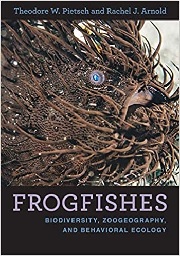Frogfishes: Biodiversity, Zoogeography, and Behavioral Ecology

Theodore W. Pietsch and Rachel J. Arnold
Johns Hopkins University Press, £92.50
In 1987, Theodore W Pietch co-authored Frogfishes of the World with David B. Grobecker. Now his latest book, with co-author Rachel J. Arnold, brings together current information about these fish that resemble frogs (or more often, rocks and corals) - thought ‘beautiful’ by many but ‘grotesque’ by others.
Nearly 5,000 specimens around the world were studied and over 30 years of literature reviewed. Updated material includes new species, changes in geographic distributions, shifts in evolutionary relationships and conservation issues. The 52 species of frogfish form the Antennariidae, a family of anglerfish. Frogfish are characterised by “maintaining the immobile, inert, and benign appearance of a sponge or coralline-algae-encrusted rock, while wiggling a highly conspicuous lure”. the lure is modified from the first of three dorsal spines to attract prey towards a mouth that can expand twelvefold. When frogfish move, they ‘walk’ using muscular pectoral fins or use jet propulsion.
The introduction starts with the earliest known depiction of a frogfish, a woodcut from 1633. Subsequent chapters cover biodiversity, fossil records, zoogeography, behavioural ecology and more. Found in seas around the world, apart from, curiously, the Mediterranean, frogfish display considerable variation in reproductive habits; some lay eggs while others demonstrate parental care. The final chapter focuses on ‘tips for aquarists and divers and the need for conservation’. Frogfish are vulnerable for many reasons including over-collecting and climate change; ways of addressing these threats are described.
Enhanced by colourful photographs and fine line drawings, the book also includes a glossary and 65 pages of references. Frogfishes is a substantial (1.8 kg) and impressive text, scientifically detailed, yet readable. It should particularly interest ichthyologists, marine ecologists, animal behaviourists, taxonomists, conservationists, curators, aquarists, divers, underwater photographers, anglerfish enthusiasts and natural historians.
Dr Sue Howarth CBiol FRSB


